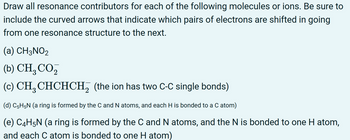
Chemistry
10th Edition
ISBN: 9781305957404
Author: Steven S. Zumdahl, Susan A. Zumdahl, Donald J. DeCoste
Publisher: Cengage Learning
expand_more
expand_more
format_list_bulleted
Question

Transcribed Image Text:Draw all resonance contributors for each of the following molecules or ions. Be sure to
include the curved arrows that indicate which pairs of electrons are shifted in going
from one resonance structure to the next.
(a) CH3NO2
(b) CH, CO,
(c) CH CHCHCH2 (the ion has two C-C single bonds)
(d) C5H5N (a ring is formed by the C and N atoms, and each H is bonded to a C atom)
(e) C4H5N (a ring is formed by the C and N atoms, and the N is bonded to one H atom,
and each C atom is bonded to one H atom)
Expert Solution
This question has been solved!
Explore an expertly crafted, step-by-step solution for a thorough understanding of key concepts.
Step by stepSolved in 2 steps with 1 images

Knowledge Booster
Similar questions
- Draw Lewis structures and any contributing resonance structures for each structure below. Use the proper type of arrow to indicate that they are resonance structures. In which structure is resonance more important? (a) H2SO3 (b) (HSO3)^1- (c) (SO3)^2-arrow_forwardDraw Lewis structures for the following compounds and ions, showing appropriateformal charges.(a) [CH3OH2 ]+ (b) NH4Cl (c) (CH3)4NCl(d) NaOCH3 (e) +CH3 (f) -CH3(g) NaBH4 (h) NaBH3CN (i) (CH3)2O¬BF3(j) [HONH3]+ (k) KOC(CH3)3 (l) [H2C“OH]arrow_forwardFormic acid has the chemical formula HCOOH. It is a colorlessliquid that has a density of 1.220 g/mL. (a) The carbonatom in formic acid is bound to one H and both O’s. Drawthe Lewis structure for formic acid, showing resonance ifpresent. (b) Formic acid can react with NaOH in aqueoussolution to produce the formate ion, HCOO-. Write thebalanced chemical equation for this reaction. (c) Draw theLewis structure of the formate ion, showing resonance ifpresent. (d) How many milliliters of a 0.100 M solution ofNaOH would it take to completely react with 0.785 mL offormic acid?arrow_forward
- (a) Complete the Lewis structure for vinyl chloride by showing all unshared pairs of electrons. (b) Predict the H-C-H, H-C-C, and Cl-C-H bond angles in this molecule. (c) Does vinyl chloride have polar bonds? Is it a polar molecule? Does it have a dipole?arrow_forwardUsing just a periodic table (not a table of electronegativities), decide which of these is likely to be the most polar bond. Explain your answer! (a) C-F (b) S-F (c) Si-F (d) O-Farrow_forwardDraw a Lewis Structure for each of the following species and assign formal charge where appropriate. Using electronegative values from the period table that was provided identify polar covalent bonds and label the atoms δ+ and δ−. For each of the molecules indicate whether or not it has a dipole moment. (a)CH5N (b) HCN (c) H2CO (d) CH3NC(e) CH3SOCH3 (f) H6BNarrow_forward
- Which of the following are not related as resonance structures? OH (A) `NH. NH (B) ОН (C) CH2 (D)arrow_forwardFinish the following questions. ((a) Draw all of the possible Lewis structures (including reasonance structures) of the following compounds.(b) Label the formal charge for each atom.(c) Determine which resonance structure(s) is(are) the better/best and briefly explain. ClO2F2+arrow_forwardDraw a Lewis structure for each of the following molecules: (a) chlorodifluoromethane, CHClF2 (b) propanoic acid, C2 H5CO2H (basic structure pictured below) (c) acetonitrile, CH3CH (the framework is H3C-C-N) (d) allene, H3CCCH2arrow_forward
- 16. Which of the following structures is the CORRECT resonance structure of the following. molecule: (A) (B) (C) (D) CH3- CH₂ CH3 -H CH₂CH3 CH₂CH-CH₂ CH3 CH3arrow_forwardWrite Lewis formulas, including unshared pairs, for each of the following. Carbon has four bonds in each compound. (a) Propane (C3H8) (c) Methyl fluoride (CH3F) (b) Methanol (CH4O) (d) Ethyl fluoride (C2H5F)arrow_forwardHow are you supposed to do this?arrow_forward
arrow_back_ios
SEE MORE QUESTIONS
arrow_forward_ios
Recommended textbooks for you
 ChemistryChemistryISBN:9781305957404Author:Steven S. Zumdahl, Susan A. Zumdahl, Donald J. DeCostePublisher:Cengage Learning
ChemistryChemistryISBN:9781305957404Author:Steven S. Zumdahl, Susan A. Zumdahl, Donald J. DeCostePublisher:Cengage Learning ChemistryChemistryISBN:9781259911156Author:Raymond Chang Dr., Jason Overby ProfessorPublisher:McGraw-Hill Education
ChemistryChemistryISBN:9781259911156Author:Raymond Chang Dr., Jason Overby ProfessorPublisher:McGraw-Hill Education Principles of Instrumental AnalysisChemistryISBN:9781305577213Author:Douglas A. Skoog, F. James Holler, Stanley R. CrouchPublisher:Cengage Learning
Principles of Instrumental AnalysisChemistryISBN:9781305577213Author:Douglas A. Skoog, F. James Holler, Stanley R. CrouchPublisher:Cengage Learning Organic ChemistryChemistryISBN:9780078021558Author:Janice Gorzynski Smith Dr.Publisher:McGraw-Hill Education
Organic ChemistryChemistryISBN:9780078021558Author:Janice Gorzynski Smith Dr.Publisher:McGraw-Hill Education Chemistry: Principles and ReactionsChemistryISBN:9781305079373Author:William L. Masterton, Cecile N. HurleyPublisher:Cengage Learning
Chemistry: Principles and ReactionsChemistryISBN:9781305079373Author:William L. Masterton, Cecile N. HurleyPublisher:Cengage Learning Elementary Principles of Chemical Processes, Bind...ChemistryISBN:9781118431221Author:Richard M. Felder, Ronald W. Rousseau, Lisa G. BullardPublisher:WILEY
Elementary Principles of Chemical Processes, Bind...ChemistryISBN:9781118431221Author:Richard M. Felder, Ronald W. Rousseau, Lisa G. BullardPublisher:WILEY

Chemistry
Chemistry
ISBN:9781305957404
Author:Steven S. Zumdahl, Susan A. Zumdahl, Donald J. DeCoste
Publisher:Cengage Learning

Chemistry
Chemistry
ISBN:9781259911156
Author:Raymond Chang Dr., Jason Overby Professor
Publisher:McGraw-Hill Education

Principles of Instrumental Analysis
Chemistry
ISBN:9781305577213
Author:Douglas A. Skoog, F. James Holler, Stanley R. Crouch
Publisher:Cengage Learning

Organic Chemistry
Chemistry
ISBN:9780078021558
Author:Janice Gorzynski Smith Dr.
Publisher:McGraw-Hill Education

Chemistry: Principles and Reactions
Chemistry
ISBN:9781305079373
Author:William L. Masterton, Cecile N. Hurley
Publisher:Cengage Learning

Elementary Principles of Chemical Processes, Bind...
Chemistry
ISBN:9781118431221
Author:Richard M. Felder, Ronald W. Rousseau, Lisa G. Bullard
Publisher:WILEY